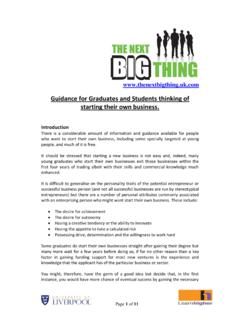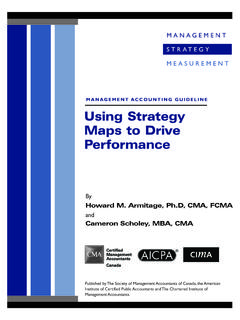Transcription of 11. Reflection - Free teaching & learning resources for UK ...
1 11. Reflection In this study guide: What is Reflection ? Becoming reflective How is reflective practice applied in academic life? Reflective writing Reflective writing for assessment For further information and the full range of study guides go to: The best thing any education can bequeath is the habit of Reflection and questioning.' (AC Grayling, The Guardian: ). What is Reflection ? When we reflect, we consider deeply something which we might not otherwise have given much thought to. This helps us to learn. Reflection is concerned with consciously looking at and thinking about our experiences, actions, feelings and responses and then interpreting or analysing them in order to learn from them (Boud et al., 1994; Atkins and Murphy, 1994). Typically we do this by asking ourselves questions about what we did, how we did it and what we learnt from doing it.
2 Sch n (1991) distinguishes between Reflection -on-action and Reflection -in-action in the following way: Reflection -in-action is concerned with practicing critically. So, a physiotherapy student working with a client on an exercise programme is making decisions about the suitability of particular exercises, which exercise to do next and judging the success of each exercise at the same time as they are conducting the activity. Reflection -on-action on the other hand, occurs after the activity has taken place when you are thinking about what you (and others) did, judging how successful you were and whether any changes to what you did could have resulted in different 2. outcomes. This is usually the type of Reflection which you are asked to write about as part of your studies.
3 Here is an example of Reflection -on-action in the discipline of Social Work: You are a social work student reflecting on a role-play which you participated in earlier in the day. The role-play involved various professionals, including social workers and their clients. Reflection leads you to recall the planning you did before the role play began, the events and processes which took place during the role play, the way you responded to other participants and your overall contribution to the role-play. You may note interactions with which you were either satisfied or dissatisfied and you might also have ideas for how it could have been done differently. Reflecting on this event will also have the result of reminding you about how the role-play made you feel: frustrated, confident etc.
4 Box 1: Reflection -on-action Reflecting on academic or professional practice in this way may make your personal beliefs, expectations and biases more evident to you. This understanding of yourself should help you to carry out your studies more successfully as it makes you aware of the assumptions that you might make automatically or uncritically as a result of your view of the world. Becoming reflective The skills associated with stepping back and pausing to look, listen and reflect, are closely related to those concerned with critical thinking which also requires you to unpack' whatever you are focusing on, not simply accept what you read or hear at face value. Through this process you will probably identify things you would not otherwise notice. Moon (2004: 181) notes similarities between being reflective and using an imaginary instrument called a pensieve' (Rowling, 2000: 518) in Harry Potter and the Goblet of Fire: One simply siphons the excess thoughts from one's mind, pours them into the basin, and examines them at one's leisure.
5 It becomes easier to spot patterns and links, you understand, when they are in this form.'. (Rowling, 2000: 518). The key to reflecting is spotting the patterns and links in thought which emerge as a result of your experiences in life and in learning . Sometimes this is difficult for learners because the focus is on you and this might not feel comfortable especially in an academic context where you are usually encouraged to depersonalise your work particularly your essays and reports. Remember, you try to avoid saying I' in essays? So, when writing reflectively, you need to find a way to be both academic and also personal and that is not always easy. You may be both referencing academic theory and, in the same piece of writing, describing an exciting learning experience you had during a seminar.
6 Becoming reflective is, in part about feeling comfortable with this dual process. Study Guide 11: Reflection ' learning Development, University of Plymouth (2010). 3. The great benefit of including Reflection in your learning is that, by understanding why you do something in a particular way and recognising how you feel about it, you can spot where your strengths and weaknesses lie. This gives you the chance to build on your strengths and develop strategies to minimise your weaknesses. Here is an example of this in the context of essay-writing: You might think that you are not very good at writing essays. Closer Reflection might help you to see that, of the many different things which could present you with problems, getting started on the actual writing of an essay is the thing you have the greatest difficulty with.
7 By using strategies which help you to overcome that particular challenge when writing essays, you can change your whole perception of yourself as an essay-writer. Strategy 1: free-writing - write on the topic of your choice for a specified length of time, such as 5 minutes, without stopping, reading back or editing at all. This technique should get you writing and thinking. Note: The text you produce through free-writing is not going to form part of the finished version of your essay but it should help you to get over the writing hurdle (for more information about free-writing, see: Elbow, 1998). Strategy 2: mind mapping use a mind-map to plan and organise all your content, literature and allocate numbers of words to each section. Begin writing straight away starting with any section of the essay except the introduction and in the end, you can jigsaw it all together.
8 Box 2: Using Reflection to improve essay writing Did you know that your beliefs about learning are extremely powerful and very difficult for you to change? So, if you believe that exams are the best form of assessment, even positive experiences with coursework assessments will not easily dislodge your learner belief. Your feelings also influence your learning and it can be both fascinating and uncomfortable to use Reflection to discover' how you really feel! Here is an example of how your feelings influence your learning : You are learning a foreign language and you don't like speaking in the foreign language in class because you feel self-conscious. So you contribute as little as possible and this has an effect on your learning . Your friend, on the other hand, loves speaking in the foreign language and speaks as much as possible.
9 Your feelings have led to completely different learning experiences. Box 3: Feelings and learning Do not be discouraged by the suggestion, discussed by Moon, that some people simply cannot reflect (Moon, 2004: 88). because it is at odds with their way of thinking. It does appear to be true that some learners have difficulty in understanding what is required of them or resist engaging with Reflection and it may also be true that some subject disciplines have an approach which corresponds better with reflective discourse than others. Study Guide 11: Reflection ' learning Development, University of Plymouth (2010). 4. However, there are ways in which you can overcome these challenges and one way is to use the Critical Thinking Model (Fig: 1, below). The Critical Thinking Model is especially helpful for those learners for whom reflective thinking and writing seems at odds with the type of study they usually do but it is, of course, a useful model for all learners.
10 The Critical Thinking Model contains a set of carefully ordered questions which move you, step-by-step through a thinking process. First you are encouraged to be descriptive, then critically analytical and finally evaluative. Each part of this process is important, but taken together, it provides a question framework which should ensure that you have addressed critical analysis or, in this case, Reflection , fully. Use of this Model for Critical Thinking enables anyone to practise Reflection successfully. Figure 1: Model to Generate Critical Thinking Model to Generate Critical Thinking Description Who? Where? Why? When? What? Analysis Topic / Issue / Title How? What next? So What? What if? Evaluation John Hilsdon, learning Development Advisor. University of Plymouth Study Guide 11: Reflection ' learning Development, University of Plymouth (2010).








